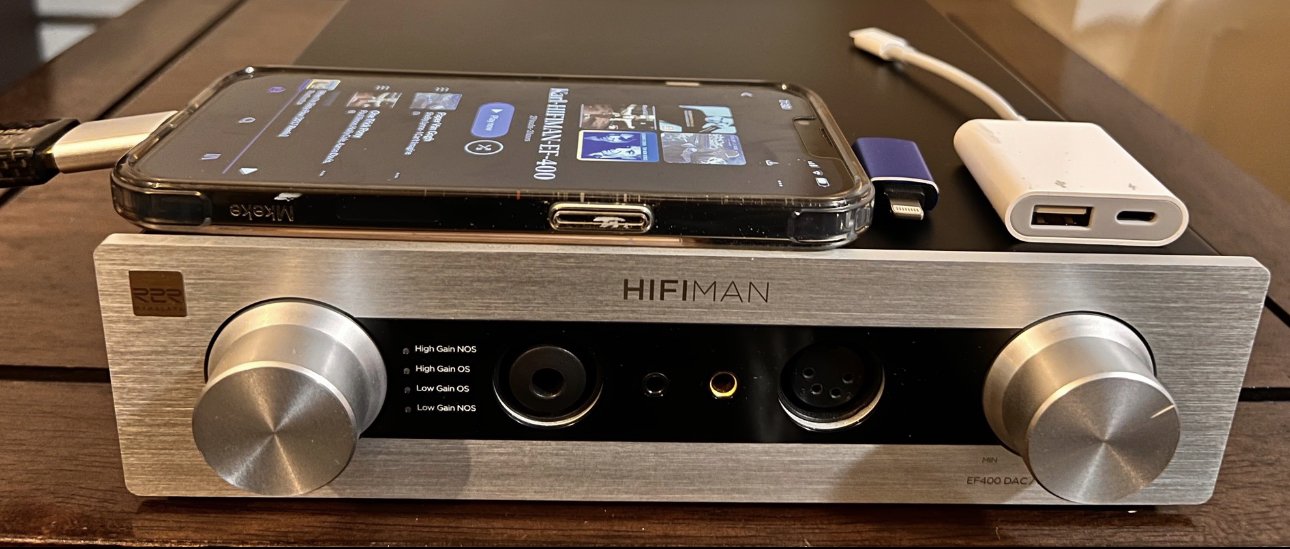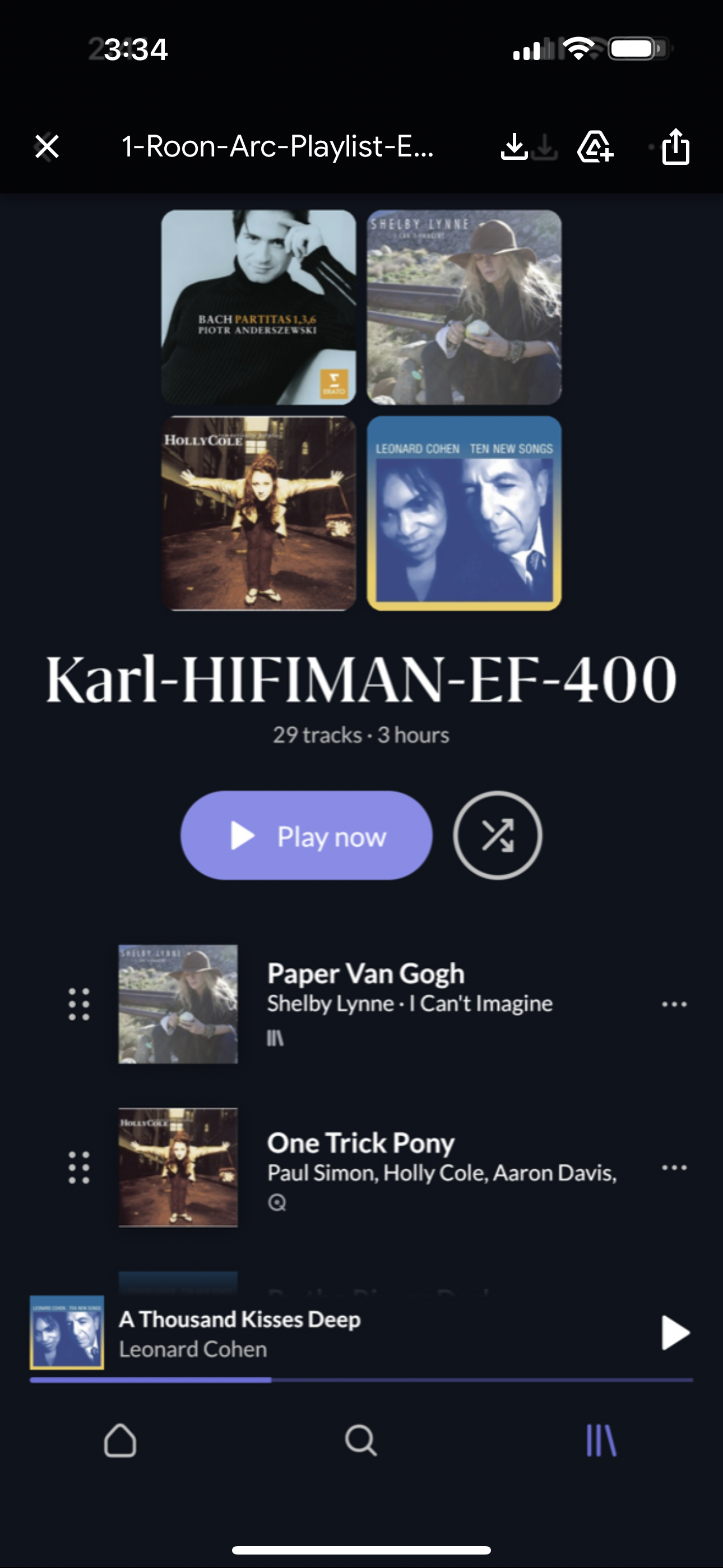HiFiMAN EF400 DAC/Headphone Amp
Every so often I become enamoured by something in the digital audio world that teaches me something new, gets me excited, and encourages me to use it; it enlarges my audiophile repertoire, and happily so. The new HiFiMAN EF400 DAC/Headphone AMP ($599) is one of those things. Coming from HiFiMAN Electronics, it is an ambitious low-priced desktop solid-state DAC/headphone amp with Class A/B amplification, fully balanced architecture, and capable of a powerful 4.4 W per channel.
Stacked with modern technology, the EF400 replaces their much more expensive 11-year-old (discontinued) EF6 headphone amp which sold at $1,599.
To keep distortion minimized, sound quality high, and simplicity a theme, it has neither wireless nor Bluetooth capabilities (in or out). Digital files enter only via USB-B and USB-C, and for headphones out there is a generous offering of four (4) choices: ¼”, 3.5mm, balanced 4.4mm, and balanced XLR four-pin. There are also four (4) gain settings: Low Gain NOS, Low Gain OS, High Gain OS, and High Gain NOS.
It even has dual (L/R) three-pin full balanced (analog) line outputs (as well as dual RCA) for connecting into a preamplifier for using the EF400 as a high-quality standalone DAC. Given the $599 price, this feature is a pleasant surprise.
Note: The volume control and gain settings are only for using headphones, not the line out. There are no analog-in capabilities, no phono preamp, etc.; this is a digital-only device.
Many thanks to Adam Sohmer, Sohmer Associates, LLC, for alerting me about the EF400 and kindly and efficiently getting me a review unit.
How does the EF400 look?
The EF400 has a nice polished and contemporary-looking silver-brushed aluminum faceplate with a tasteful symmetry in the location of controls/outputs, and a metal black chassis; it is relatively small, but solidly built: Weight: 6.6 lb (3kg), Dimensions: 9.5”(D) x 9” (W) x 2.5” (H).
Since it is a desktop unit, it needs to be plugged in with a power cord (one of your choice, or the included stock one).
FRONT: On the left side is a large silver gain knob for choosing from the four gain settings.
You can change the settings at any time, even when playing music. On the right side is a large silver volume knob that moves smoothly when turned. In the middle are the four headphone outputs.
BACK (from left to right): dual (L/R) three-pin, fully balanced line outputs, then the dual RCA (L/R) line outputs followed by the two digital inputs (USB-B and USB-C and finally the power cord connection and power switch.
The DAC
The DAC within the EF400 is the relatively new (Sept. 2021 release) HIMALAYA DAC, which is an in-house architecture (not a fixed unit) developed by HiFiMAN they modify for different uses in their products, from a mini (HM800 Mini-DAC/Amplifier, $299) to the desktop EF400 at $599: It is an R2R ladder DAC that also uses FPGAs for an efficient computational helping hand with the processing. As HiFiMAN explains,
“The HIMALAYA architecture is flexible so that it conforms to various size requirements based on the product circuit board.”
It handles PCM up to 24Bit/768Khz (no DSD or MQA), and its power consumption is (remarkably) only 20 MW. There are no filter options; more simplicity.
Further specs
The signal-to-noise ratio is 118+/- 3dB (A-Weighted), and THD + N (Line out) is between 0.002%. And 0.004%. Channel separation is 125+/-3dB.
Setting up and use
At first, I kept the EF400 close to my audio system so I could experiment with using my music server for the digital in. Knowing that I would not be using vinyl for a while, I kept the unit atop my turntable (it has a strong cover). Not being used to having a self-amplified unit around, I admit to often needlessly turning on my preamplifier before using the EF400; a habit I got over later—when I decided to bring the EF400 out of my apartment for use in my office (a revelation, more on that below).
The EF400’s hefty 3kg weight allows it to easily accommodate high-end power cables without being pulled around; I used an Audio Art Cable Statement e2 Cryo. I used only USB-B in; Wireworld Platinum Starlight series 7 and 8.
For headphones, I used two pairs:
HiFiMAN Arya (Stealth Magnetic Version) open-back headphones ($1599). Released at the same time as their Himalaya DAC, it features an impedance of 32 Ohms, a sensitivity of 94dB, and a frequency response of 8Hz – 65kHz. Its weight is 14.3 oz. (405.4 g).
The higher-end HiFiMAN Closed Back HE-R10 Planar Magnetic Headphones ($5499).
It features an impedance of 30 Ohms, a sensitivity of 100dB, and a frequency response of 10Hz – 60kHz. Its weight is 17.5 oz. (495 g).
Suffice it to say at this point, the EF400 powered each brilliantly and even both at the same time (yes, you can use more than one output simultaneously, as I discovered inadvertently.)
I tested the EF-400 in four different ways:
[1] Headphone amp with a USB cable from my reference system music server (which is connected to the internet with a cable). Streaming included Qobuz, Tidal, and my library; all via Roon.
[2] Headphone amp with the USB cable from my iPhone 13 to it. This required a tiny $10 adapter to convert the cable’s USB A (male), to a Lightning (male); sometimes called a “camera adaptor”. It worked seamlessly; the iPhone recognized the EF400 instantly and connected accordingly. This allowed streaming Qobuz from my iPhone for music (of course bypassing the iPhone DAC; right to the HIMALAYA DAC in the EF-400).
Note: Doing this yielded a potentially much louder signal than if using my music server because the iPhone volume is jointly in play: if you turn off the iPhone volume, you get no sound even if the EF400 is at full blast, and vice versa. So I used the iPhone volume just enough, then allowed the EF-400 to do the heavy lifting
[3] As a DAC only with my system/speakers, via sending the analog out using the XLR fully balanced output into my preamplifier. This proved to me that the DAC itself is worthy of consideration as a standalone especially since the entire unit is only $599; it was clean and detailed, with plenty of transparency and natural sounding timbre. I feel it competed favourably in sound quality with more expensive DACs.
Note: the headphone-outs still work in this mode and do not cut off the sound to the speakers while music is playing: they both still retain their normal volume; but, the volume and gain knobs only affect the headphones.
[4] I upped the ante with my iPhone (with USB to the EF400) armed with the Roon Arc app—which allows you to log in to your Roon Core regardless of where you are. This led to the revelation I mentioned earlier: It allowed me to take the EF400 out of my apartment to my office and pull in (losslessly), through the iPhone, all my Roon-controlled from-home music as if I were at home. The iPhone pulls in wirelessly if a wireless connection is available, and otherwise uses the phone's mobile data capabilities. This was stunning; the sound quality through the EF400 was superb, and the connection was flawless. Bravo.
The Roon Arc method completely won me over: it became my modus operandi with the EF400: I kept it in my office for the rest of this review.
The sound of music
I created a Roon Playlist, Karl-HIFIMAN-EF-400, that I used for this review. I also allowed Roon Radio mode on sometimes (meaning that it selects music tracks for you based on your past preferences). The playlist contains 29 tracks and is 3 hours long; I list a small sample below.
“One Trick Pony”, Holly Cole, from Romantically Helpless. Alert Records (2000).
The Beatles (Paul McCartney). “Blackbird” (2018 Mix, 24/96).
“The Land of Plenty”, Leonard Cohen, Ten New Songs (beautiful harmonies with Sharon Robinson). Columbia Records (2001).
Norah Jones sang “Steer Your Way”, Peter Gabriel sang “Here it is”, and Sarah McLachlan sang “Hallelujah” on Here It Is: A Tribute To Leonard Cohen. Blue Note (2022). And while we’re at it, on the same album, “Bird on the Wire”, sung by guitarist Bill Frisell’s guitar. (A tremendous tribute; Frisell plays guitar on every track. It also has many others including James Taylor, Emmanuel Wilkens, and even Iggy Pop.)
Two classical examples played on repeat and sounded particularly vibrant and in scale:
Handel’s Water Music Suite No. 2. HWV 349, Akademie für Alte Musik Berlin. Harmonia Mundi (2016)
“Bach Partita For Keyboard No. 1”, from Bach Partitas 1,3,6. Piotr Anderszewski on piano. Erato (2002)
I mainly used the HiFiMAN Arya Stealth Magnetic headphones; I found them a perfect fit with the HE400: together they offered a natural presentation endowed with a rich, smooth but detailed sound that never fatigued. The bass went deep, the midrange was sweet, and the high-frequencies were never irritating. Also, the Arya was comfortable and made me appreciate the sound of open-back versus closed-back headphones.
Voices sounded particularly intimate and close up, rendering the singer as if inches away, sometimes a truly remarkable illusion. Headphones can do that, and I greatly enjoyed the effect of the EF400. Because of this, harmonies too were especially enjoyable, sometimes because the singers’ differences would sometimes appear stronger as the singers appeared to be coming close at you from different directions; another enjoyable illusion.
Summary
With the EF400, HiFiMAN has created an impressive-sounding, contemporary-looking and powerful desktop DAC/Headphone amp at only $599. With an emphasis on simplicity of features/use on the one hand, coupled with its ability to easily engage with the complex world of streaming on the other hand, I think HiIFiMAN has a winner on their hands. And they also have headphones to match. Highly recommended.
Further information: HiFiMAN








